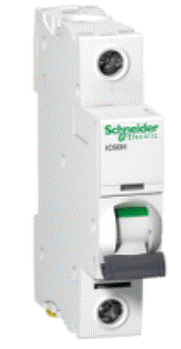Differences Between Miniature Circuit Breakers (MCB) Class A, B, C, D, K and Z Type
Miniature circuit breakers (MCBs) are switches that operate automatically in order to provide protection against overload or short circuit conditions.
MCBs are classified into different types based on overcurrent trip conditions.
The difference between each type, or class, of MCB, is determined by the current at which the MCB will trip instantaneously. The exact time to trip (interrupting time) at a given current can be determined by an MCB trip curve.
These MCB types are also known as classes or curves.

Table of MCB Types
| MCB Type | Trips Instantaneously At |
| Curve A | 2-3x Rated Current |
| Curve B | 3-5x Rated Current |
| Curve C | 5-10x Rated Current |
| Curve D | 10-20x Rated Current |
| Curve K | 8-12x Rated Current |
| Curve Z | 2-3x Rated Current |

Type A Miniature Circuit Breakers
Type A MCBs are the most sensitive and are rarely used. They are designed to trip instantaneously above 2-3 times the rated current.
As a result, they are only used for the most sensitive devices.
Type B Miniature Circuit Breakers
Type B MCBs are designed to trip instantaneously above 3-5 times the rated current.
Used mainly for domestic and commercial applications at low voltages, where an overcurrent is likely to be low. These include home wiring and lighting applications. They are generally not used for inductive applications like motors.
Type C Miniature Circuit Breakers
Type C MCBs are designed to trip instantaneously at currents 5 to 10 times the rated current.
Commonly used in commercial and industrial applications, type C MCBs are frequently used for small motors, fans, transformers, and fluorescent lighting.
Type D Miniature Circuit Breakers
The least sensitive MCB, Type D MCBs are designed to trip instantaneously at currents 10 to 20 times the rated current.
This makes them suitable for highly inductive loads and other applications involving strong power surges. Applications of Type D MCBs include uninterruptible power supplies (UPSs), large motors, transformers, X-ray machines, and welding equipment.
Type K Miniature Circuit Breakers
Often used for motors, Type K MCBs are designed to trip instantaneously when the current reaches 8 to 12 times the rated current.
Type K and type D MCBs have very similar characteristics. The primary difference is that Type K MCBs will trip faster when the current is slightly above the rated current. This makes them more sensitive than Type D MCBs while still being suitable for inductive applications like motors.
Type Z Miniature Circuit Breakers
Similar to Type A MCBs, Type Z is designed for sensitive applications. They are designed to trip instantaneously when the current reaches 2-3 times the rated current. Type Z MCBs are commonly used to protect semiconductor circuits.
How to Choose a Miniature Circuit Breaker (MCB)
There are four factors you need to take into account when choosing an MCB:
1) Current rating. This is the rated current on which the tripping characteristics will be based.
2) Tripping characteristics. The multiple of the current rating at which you want the MCB to trip. This will determine the MCB Type.
3) Breaking capacity. The breaking capacity is the maximum current and voltage that the MCB is designed to safely interrupt. The breaking capacity may also be given as the maximum current at a given voltage.
4) Number of poles. The number of poles determines the number of phases (or circuits) that you can protect with a single device. A single pole MCB will only protect one circuit, while a three (3) pole MCB will protect up to three circuits. An overload on any one pole will cause the MCB to trip.
Another factor to consider is the durability, or endurance, which tells you the number of cycles that the MCB is designed to operate for. In general, an MCB will be designed to be manually operated twice.
Always check the data sheet of a specific MCB where you will find helpful specifications and guidance.